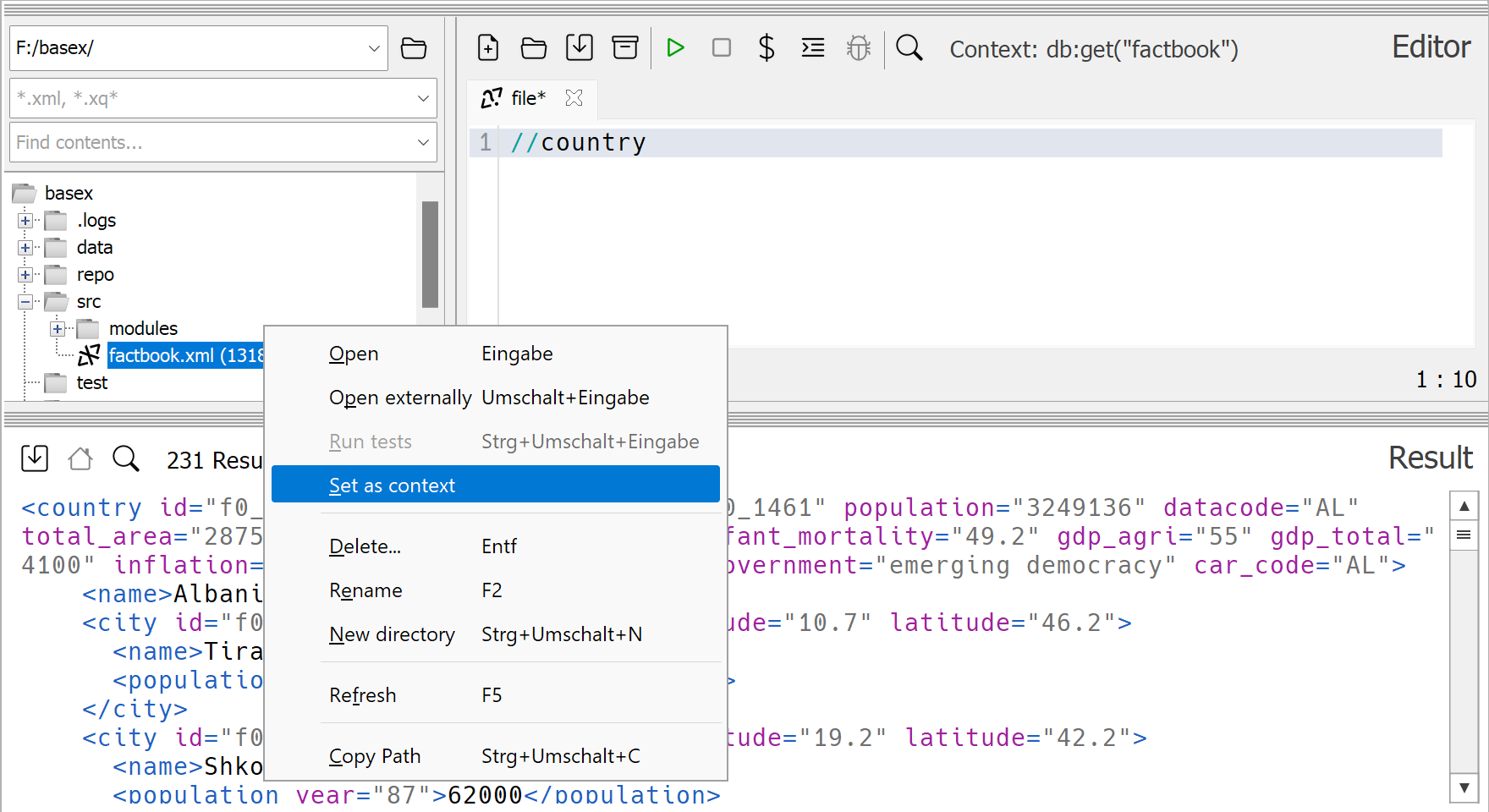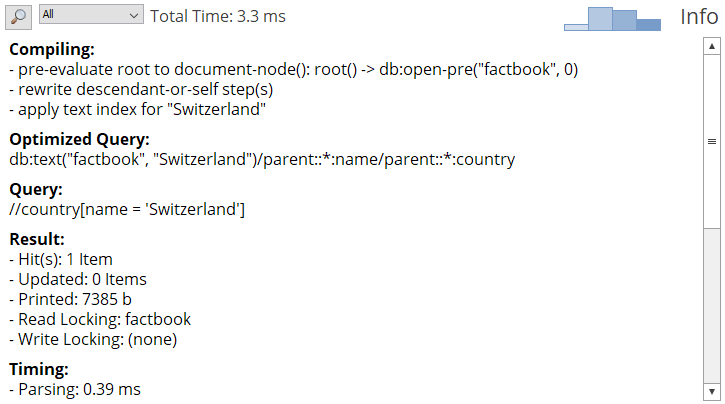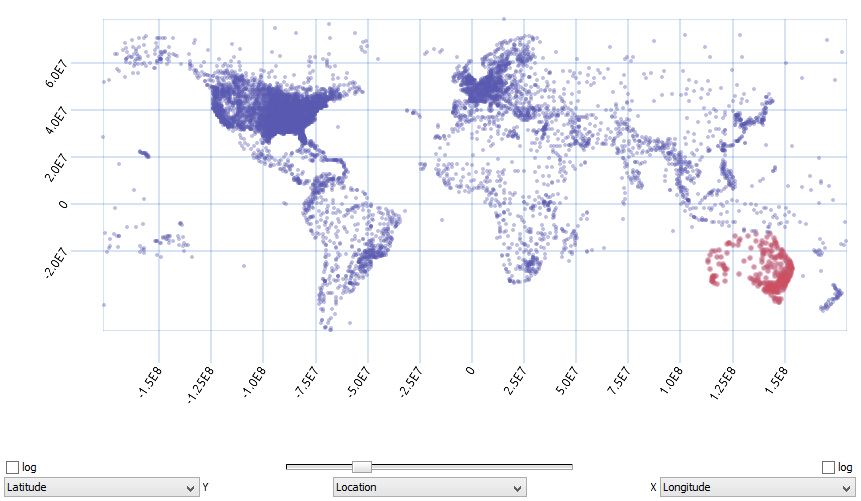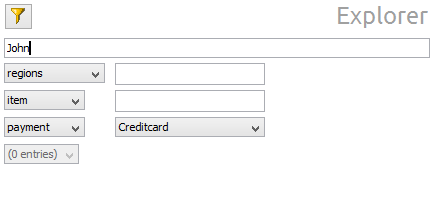Graphical User Interface
BaseX comes with a graphical user interface that offers you great tools for managing, querying and visualizing your data and for writing complex applications in XQuery.
Startup
The graphical user interface can be started as follows:
- If you have installed BaseX on Windows, click on the BaseX GUI icon.
- Run one of the Start Scripts.
- Double-click on the
BaseX.jarfile (this way, no libraries will be added). - For developers: type in
mvn exec:javain the main directory of thebasexproject.
Some additional Command-Line Options are available.
It is worth mentioning that the GUI must not be used if you perform parallel (concurrent) read and write operations on your databases. See Concurrent Operations for more details.
Introduction
At the top of the BaseX window, the menu bar resides. It houses all important features of the BaseX GUI. Use the Database menu to create and manage your XML databases. The Editor menu gives you access to a variety of tools and options for working with files. The View menu lets you toggle between the bars and panels described below. The Visualization menu offers you a comprehensive set of data representations that will help you to understand your data even better. Use the Options menu to set your preferences regarding real-time execution, colors, fonts, and packages.
Right below the menu bar, you can find the Buttons bar and just below that the Input Bar. The Buttons bar offers you a wide range of shortcuts, mostly for menu options, such as managing databases and displaying views and visualizations, but also for navigating through your data. With the Input Bar, you can query your data using three different kinds of query syntax.

The Status Bar is situated at the bottom of the BaseX window.
The BaseX editor consists of the Project view, a file browser with optional input fields for searching files, and the actual Editor panel with buttons for creating, opening, saving, searching, executing and debugging your files.

In addition to that, the Result view displays the output of queries and database operations and the Info view shows you information about database processes and query execution.

To gain further insights into your data, you can choose to display various visualizations such as Map, Tree, Folder, Plot, Table and Explorer.
Database Management
The BaseX GUI is a great place for creating and managing your XML databases.
To create a new database, select Database → New from the menu. You can either leave the “input file or directory” field empty, or you can choose an XML document or a directory with multiple resources. You can start with the factbook.xml document, which contains statistical information on the worlds’ countries. It is included in the etc directory of our full distributions (ZIP Package and Windows Installer) or can be downloaded here (1.3 MB). In the Create Database dialog, specify the path to your input file and the name of the new database. Click the OK button to create the database.
Note: You can also use the GUI’s editor to create and edit your own XML document. Just specify it as input file for the creation of a new database after saving the document to disk.
To open, rename, copy or drop a database, choose Database → Open & Manage... from the menu. Select one of the available databases on the left-hand side and click on one of the buttons on the right: Open, Rename, Copy or Drop. To open a database, you can also double-click on the database name.
Opening a database activates three more options in the Database menu:
- The Properties item gives you access to a variety of database options and information:
- Add resources and/or set parsing preferences.
- Gain insights into element and attribute names, paths and other meta information.
- Create and manage text, attribute, token and full-text indexes. Customize indexes by specifying language, stemming, case-sensitivity and diacritics settings or include a stop word list.
- With the Export item, you can serialize your database into a whole range of different output formats, including XML, JSON and CSV.
- The Close item closes the database. An open database is closed automatically as soon as another database is opened.

Editor
The built-in editor of BaseX is a powerful tool for write XQuery code and Command Scripts, editing text documents (XML, JSON, JavaScript, …), and developing RESTXQ applications:
- The editor offers native syntax highlighting for XQuery, XML, JSON and JavaScript.
- XQuery, XML and JSON files will be parsed in real time and errors will be highlighted.
- XQuery code and command scripts can be executed (via Ctrl Enter or by clicking on the green triangle).
Numerous keyboard shortcuts are available to speed up editing and debugging. Some examples:
- Ctrl H: Search for the currently selected string in your complete project.
- Ctrl .: Jump to the next erroneous code in your project.
If you right-click on an XML document in the Project view, the selected file will be parsed and bound to the context item:

Project View
The Project view is attached to the Editor panel. It displays all files of the current project directory in a tree structure. Files can be renamed and deleted by right-clicking on the files. The project directory can be changed as well; the most recent directories will be kept in the history.
All XQuery files in the project directory will be parsed in the background. Buggy XQuery modules, and files importing these modules, will be marked red. With the text fields on top, you can interactively search for file names and contents.
If a directory contains a .ignore file, its files and contents will be ignored.
Input Bar
The Input Bar is situated on top of the main window. It offers you three different modes to query your XML databases: Find, XQuery and Command.

The upcoming example queries can all be used with an instance of the factbook database:
Find
In the Find mode, the input bar can be used to find single elements and texts in the currently opened database. The following syntax is supported:
| Query | Description |
|---|---|
city |
Find elements named city, and texts containing this token. |
=India |
Find texts matching the exact string India. |
~Cingdom |
Find texts equal or similar to the token Cingdom. |
@id |
Find attributes named id and attribute values containing this token. |
@=f0_119 |
Find attribute values matching the exact string f0_119. |
"European Chinese" |
Find texts containing the phrase "European Chinese". |
//city |
Leading slash: Interpret the input as XPath expression (see below). |
XQuery
In the XQuery mode, XPath and XQuery expressions can be entered in the input bar.
To evaluate the following example queries, type them in the input bar and press Enter or click on the Run query button (green triangle) adjacent to the input bar:
| Query | Description |
|---|---|
//country |
Return all country elements. |
//country[name = "Switzerland"] |
Return the country with the value “Switzerland”. |
|
Return the names of all cities with a population larger than one million and order the results by the name of the city. |
Command
In the Command mode, BaseX Commands can be entered and executed. Just try the following examples:
INFO: Returns system information.CREATE DB TEST: Creates an empty database namedTEST.LIST: Lists all databases.
Visualizations
The BaseX GUI offers various visualizations, which help you to explore your XML data instances from different perspectives:
|
Result (View menu)
Displays query results and other textual output (e.g., content of the currently open database). Query results can be saved in a file. |
 |
Info (View menu)
Helpful for analyzing the query plans of your XQuery expressions. It also displays information on the compilation and evaluation of queries. |
 |
|
Map
Displays all data in a TreeMap. All nodes of the XML document are represented as rectangles, filling the complete area. You can choose different layout algorithms in the Menu Options → Map Layout. |
 |
Tree
Displays all XML nodes in a top-down tree with edges and nodes. You can change some settings of the Tree in the Menu Options → Tree Options. |
 |
|
Folder
Displays all nodes in an Explorer-like folder view. Nodes can be expanded or closed by clicking on the arrows. |
 |
Plot
Displays all nodes in a scatter plot, which is particularly helpful if you want to explore analyze your data. Three dropdown menus allow custom axis assignments. |
 |
|
Table
Comes in handy if your data is highly regular. It displays all nodes in a table with rows and columns. Different assignments can be chosen by clicking on the arrow in the right upper corner. |
 |
Explorer
Can be used to explore the contents of your database via drop-down menus, search fields and double sliders. |
 |
Real-time Options
In the Options menu, you can change how queries are executed and visualized:
- Real-time Execution: If real-time execution is enabled, your searches and queries will be executed with each key click and the results will be instantly shown.
- Real-time Filtering: If enabled, all visualizations will be limited to the actual results in real-time. If this feature is disabled, the query results are highlighted in the visualizations and can be explicitly filtered with the Filter button.
Look and Feel
By default, the Look and Feel of your operating system will be used in the GUI. In the Preferences dialog, you can choose from additional window themes.
Changelog
Version 11.0- Added: All text panels provide full Unicode character support
- Added: Font Dialog: Option for faster anti-aliasing.
- Updated: Project View: ignore directories with
.ignorefile.
- Added: Project View, set XML document as context.
- Added: highlighting of erroneous XQuery modules in the project view.
- Updated: support for dark look and feels; support for JTattoo library.